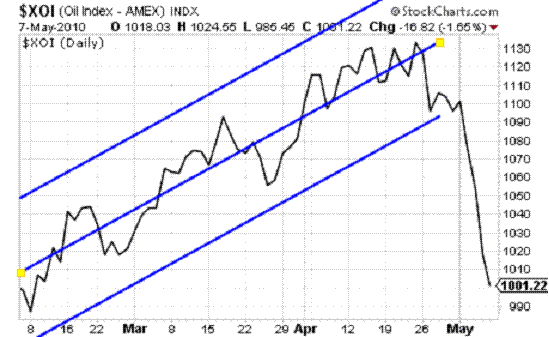- Oil Stocks Get a Haircut
- What’s the trend for oil?
- What my barber knows about oil
Fellow Resource Prospector,
There’s nothing like a
haircut to make you feel better about yourself. I was long overdue for one until this past weekend. When my hair gets too long I can always brush
it back or mat it down, but there comes a day when I say enough – it’s
time. For me, the motivating factors were
a few sideways looks and subtle hints from my wife.
I’m not
the only one to get a haircut this past week. The first week of May proved disastrous for oil prices, and by direct
correlation, oil stocks. The motivating
factor was a lack of price support. I’ll describe this in detail in a
moment.
The largest index of oil
companies, called the NYSE Arca oil index (AMEX:
XOI), fell nearly 10% last week. This index tracks the 13 largest oil companies in the production,
exploration and development sectors.
I’ve drawn a price channel
showing the uptrend from February lows. These
three lines represent the median price in the middle, the highest high up top,
and the lowest low at the bottom. It’s
hard to believe, but traders put a lot of stock (literally) into price channel trends. And as soon as trends go the other way,
they’ll pull every penny out of harm’s way.
You can
see how there was some level of support at 1100 – but when prices didn’t hold
there, it was look out below. That price
level of 1100 was an important one for traders. You can eyeball the extension of the trend and see that 1100 was the
bottom level for the uptrend.
Obviously, the oil stock
haircut is still in progress. Like any
trend, this downtrend will continue until it stops. I’ve talked about price trends before, and I
realize that statements like the one above sound a little obvious. But it’s true! I’m not a trader by any means, but looking at
a chart and picking a future bottom is a lot harder than looking at a chart and
seeing a current trend.
The chart above represents
what’s known as a falling knife for the month of May. Prices are falling so far, and so fast, that
to try to pick the perfect time to buy as they’re falling would be like trying
to catch a knife dropped from a 100 story building. Sure, you might be able to do it and beat the
crowds, but it’s so much easier and very much safer to wait until it hits the
pavement. Then you can pick it up
without worrying about losing an arm or a leg in the process.
If you’re not an owner of
oil stocks, or you want to own more oil stocks, wait until this knife hits the
pavement and the trend reverses, THEN it will be the time to add to or start a
position.
This 13 company index could
test the year-to-date lows of 990 – but there are also the sub-800 lows of just
over a year ago to contend with as well. I won’t pretend to know which lows the index will test, but I’ll look
for any reversal at these key numbers as a time to buy.
I realize
all of this talk might sound suspiciously like I’m telling you to time the
market. But I’m not. I think we can all agree – even my barber –
that oil prices are headed much, much higher in our lifetimes. So it’s not a question of if, but when, we
should buy oil stocks. The answer of
when, is: once their prices have stopped falling like a dropped knife. That’s not timing the market. We’re not picking a bottom; we’re waiting for
an uptrend.
But enough trader-babble,
and let’s get back to my haircut: my barber Kelly wanted to know if the
gigantic oil spill off the coast of Louisiana would cause oil prices to
rise. It’s a good question. With an estimated 5,000 barrels a day going
to waste, Kelly wondered if that decreased supply would have a bullish effect
on prices.
According the EIA, the world
uses between 6.5 and 7.0 million barrels per day. The 5,000 barrels leaking in the Gulf of Mexico represents just a bit less than 1/10 of 1%
of daily consumption. So, the answer is,
no, this wasted oil will not have much of an effect, if any, on oil
supply.
But psychologically, the
spill is having a monstrous effect on oil stock prices. Who wants to own a company like BP (NYSE: BP) that’s responsible for such
an awful ecological disaster? Obviously
we can assign some of the blame for falling oil prices at the feet of the broad
market haircut, but a genuine hatred for the industry isn’t helping.
And while the sight of
moored fishermen, dying wildlife and polluted beaches in Louisiana tugs at my heartstrings, I haven’t
noticed a drop-off in my driving or my consumption of crude-oil fueled
goods. Have you?
As long as I’m somewhat
complicit in the destruction, it doesn’t make any sense to forego the
investment implications of cheaply valued oil stocks.
I’m looking for an
opportunity to add to my oil positions, and unless you’re a hermit or already
too rich from oil, I hope you’re doing the same.
To opportunity,
Kevin McElroy
Editor
Resource Prospector
 Facebook
Facebook
 Twitter
Twitter
